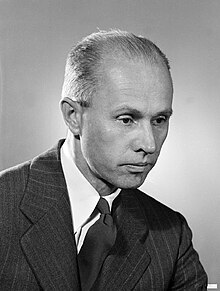
Back جورج كستياكاوسكي Arabic چورچ كيستياكوسكى ARZ جرج کیستیاکویکی AZB George Kistiakowsky Czech George Bogdan Kistiakowsky German George Kistiakowsky Basque جرج کیستیاکویکی Persian George Kistiakowsky French Գեորգի Կիստյակովսկի Armenian გეორგი კისტიაკოვსკი Georgian
George Kistiakowsky | |
|---|---|
 George Kistiakowsky | |
| Born | December 1 [O.S. November 18] 1900 Boiarka, Russian Empire (now Ukraine) |
| Died | December 7, 1982 (aged 82) Cambridge, Massachusetts, United States |
| Nationality | Ukrainian-American |
| Citizenship | American |
| Alma mater | University of Berlin |
| Known for | |
| Awards | |
| Scientific career | |
| Fields | Physical chemistry |
| Institutions | |
| Doctoral advisor | Max Bodenstein |
| Doctoral students | |
| Signature | |
 | |
George Bogdanovich Kistiakowsky (Russian: Георгий Богданович Кистяковский, Ukrainian: Георгій Богданович Кістяківський, romanized: Heorhii Bohdanovych Kistiakivskyi; December 1 [O.S. November 18] 1900 – December 7, 1982) was a Ukrainian-American physical chemistry professor at Harvard who participated in the Manhattan Project and later served as President Dwight D. Eisenhower's Science Advisor.
Born in Boyarka[1] in the old Russian Empire, into "an old Ukrainian Cossack family which was part of the intellectual elite in pre-revolutionary Russia",[2] Kistiakowsky fled his homeland during the Russian Civil War. He made his way to Germany, where he earned his PhD in physical chemistry under the supervision of Max Bodenstein at the University of Berlin. He emigrated to the United States in 1926, where he joined the faculty of Harvard University in 1930, and became a citizen in 1933.
During World War II, Kistiakowsky was the head of the National Defense Research Committee (NDRC) section responsible for the development of explosives, and the technical director of the Explosives Research Laboratory (ERL), where he oversaw the development of new explosives, including RDX and HMX. He was involved in research into the hydrodynamic theory of explosions, and the development of shaped charges. In October 1943, he was brought into the Manhattan Project as a consultant. He was soon placed in charge of X Division, which was responsible for the development of the explosive lenses necessary for an implosion-type nuclear weapon. In July 1945, he watched the first atomic explosion in the Trinity test. A few weeks later, another implosion-type weapon (Fat Man) was dropped on Nagasaki.
From 1962 to 1965, Kistiakowsky chaired the National Academy of Sciences's Committee on Science, Engineering, and Public Policy (COSEPUP), and was its vice president from 1965 to 1973. He severed his connections with the government in protest against the war in Vietnam, and became active in an antiwar organization, the Council for a Livable World, becoming its chairman in 1977.